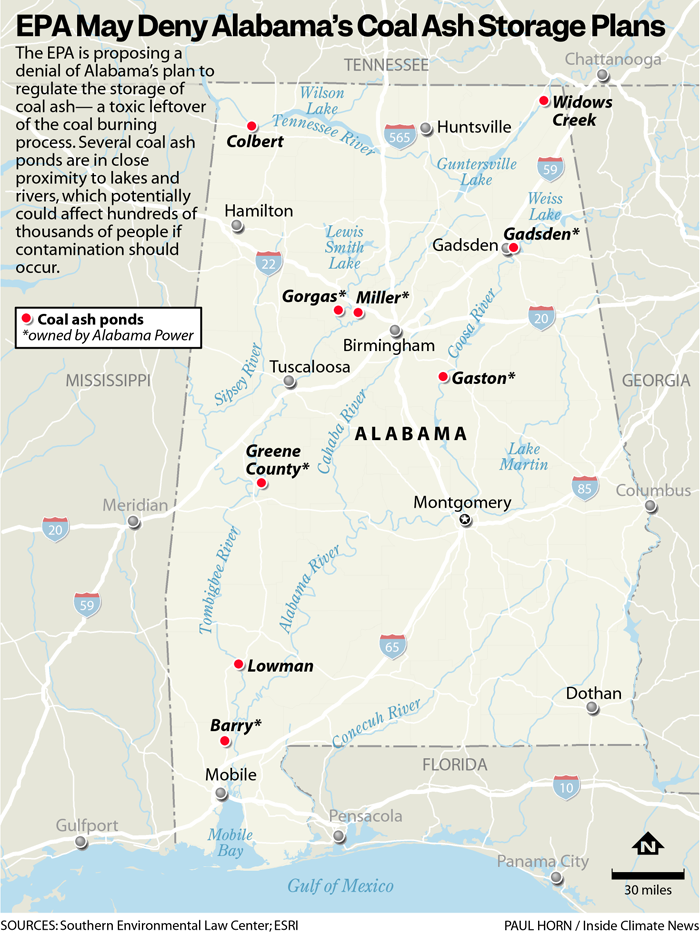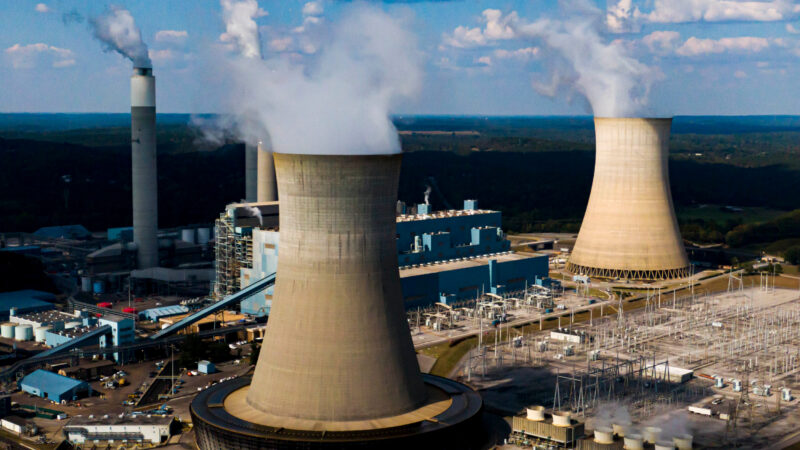Environmentalists rattled by radioactive risks of toxic coal ash
Coal ash is the primary waste product of burning coal to produce electricity at facilities like this one in Jefferson County, Alabama.
This article originally appeared on Inside Climate News, a nonprofit, independent news organization that covers climate, energy and the environment. It is republished with permission. Sign up for their newsletter here.
By Lee Hedgepeth, Inside Climate News
When the wind blows the wrong direction, Esther Calhoun can smell it.
Calhoun’s home is often downwind from the Arrowhead Landfill in Uniontown, Alabama, a site that accepted toxic coal ash in the wake of an environmental disaster in neighboring Tennessee.
Calhoun spoke out against the landfill at the time, a move that landed her in court, a defendant in a $30 million lawsuit accusing her and other residents of libel and slander against the company that owned the landfill. That suit is over now, settled in the community’s favor, but the impacts of the coal ash Calhoun decried are still simmering.
In November 2023, the Environmental Protection Agency (EPA) issued a draft risk assessment that updated the agency’s understanding of the health risks associated with coal ash, the waste left over after coal has been burned to produce electricity.
The assessment, part of EPA’s ongoing effort to expand regulations around coal ash, concludes that even small amounts of the toxic material can lead to harmful health effects, including risks of cancer 35 times higher than previously suggested by the federal regulator. The draft, which focuses on the use of coal ash in previously unregulated settings, often for so-called “beneficial” uses such as structural fill, also outlined that the presence of heavy metals like arsenic and radioactive isotopes like radium in coal ash waste could pose significant risks to human health. The draft found that those exposed to coal ash could face an “elevated cancer risk from incidental ingestion of arsenic and radium, in addition to direct exposure to gamma radiation from radium.”
These new findings raise concerns about the continued storage of coal ash in unlined pits across Alabama, experts have said, but they also raise questions about what risks citizens are being exposed to in their everyday lives. So-called “beneficial uses” of coal ash like its use in structural fill, go largely unregulated in many states. In Alabama, for example, the state environmental regulator told Inside Climate News that the agency “does not have regulations to address the use of CCR material.” CCR, or coal combustion residuals, is industry jargon for coal ash waste.
In a letter to EPA Administrator Michael Regan sent after the risk assessment’s publication, more than 150 community groups from across the country asked the federal agency to address those concerns directly:
“We ask the EPA to take the following actions: (1) quantify the full range of health risks posed by coal ash used as structural fill, particularly the risk from radiation; (2) investigate areas where coal ash fill has been placed near residences and require cleanup; (3) initiate a rulemaking to prohibit the use of coal ash as structural fill; and (4) issue a public advisory recommending that coal ash fill in residential areas be immediately terminated pending a final rulemaking.”
Calhoun said that over time, she’s become skeptical of regulators at both the state and federal level when it comes to protecting her community and those like it from the health effects of coal ash, whether it be in structural fill, a landfill, or a waste pond at a utility site. Risk assessments like the one issued by EPA amount to cheap talk, Calhoun said. Only concrete action based on those assessments, she added, will show that the agency is serious about protecting ordinary people.
How did we get here?
Calhoun thought she knew where the threat came from.
For her, it began in 2008, when a coal ash impoundment in Kingston, Tennessee, breached, spilling more than a billion gallons of toxic sludge onto over 300 acres of land and into the Emery River channel. The result was one of the largest environmental disasters in US history. The spill cost the Tennessee Valley Authority (TVA), which owned the coal impoundment, over $1 billion to clean up. Ten years after the spill, dozens of the roughly 900 workers employed during the cleanup were already dead. More than 250 were chronically ill.
In 2010, with approval from the Alabama Department of Environmental Management (ADEM), TVA transported more than 800 million gallons of toxic waste from the Kingston site to Arrowhead Landfill in Uniontown, Alabama, a majority-Black town of around 2,000 people.
That’s when Calhoun spoke up, calling out what she and other residents viewed as environmental racism. They filed civil rights complaints against ADEM alleging the regulator had acted in a racially discriminatory manner in allowing the coal ash to be placed in a nearly all-Black community. The EPA, under President Donald Trump, would eventually reject those claims. Sen. Cory Booker (D-N.J.), who’d visited Uniontown in the wake of the controversy, said at the time that the EPA had “abdicated its responsibility to protect people of color and low-income communities from blatant discrimination.”
But at least then, Calhoun said, she knew where the threat was.
In the years since Calhoun’s legal battle, environmental groups, academics, and media outlets have documented the ways utilities across the country have skirted environmental regulation of coal ash waste by promoting its “beneficial uses”—uses for which there are virtually no safeguards.
According to an annual report by the American Coal Ash Association, more than 60 percent of coal ash waste produced in the U.S. was recycled for some type of “beneficial use.” These uses include recycling in so-called “encapsulated” uses like concrete production as well as use in “unencapsulated” settings such as construction (as structural fill), agriculture, or snow and ice control.
Now, as it’s become clear that the use of coal ash hasn’t been limited to utility sites and landfills, Calhoun said the threat could come from anywhere. And the worst part, Calhoun said, is that the community has little faith that federal or state regulators will step in to help.
“They don’t care,” Calhoun said. “They’re simply not protecting people.”
The EPA’s November draft risk assessment is the latest in a series of steps by the agency to expand its role in regulating coal ash. For years, however, environmental groups have criticized the agency as slow to act when it comes to regulating coal ash.

In Alabama, coal ash is often stored in unlined pits near coal-fired power plants—pits that often leave the toxic sludge in contact with groundwater. Alabama Power, which owns most of the coal ash sites in the state, has been fined repeatedly for groundwater contamination at the sites.
Last year, the EPA announced that it plans to reject the State of Alabama’s plan for regulating coal ash waste, arguing that it does not meet even the minimal protections for public health required by federal law.
So far, however, even regulators serving Democratic administrations have shied away from the regulation of so-called “beneficial” uses of coal ash, which include its use as structural fill.
Assessing the health risks of coal ash
The EPA’s draft risk assessment looks at the health risks involved with various uses of coal ash, including its use as structural fill at utility sites across the country. Structural fill refers to material that is placed and compacted at a location like a construction site in order to improve land for an intended use. Statistics from the American Coal Ash Association suggest that between 2018 and 2022, more than 10 million tons of coal ash were used in structural fill across the country. In North Carolina, one of the few states that requires tracking of coal ash in structural fill, the waste product has been used in dozens of locations across the state, from a Marine Corps base in Craven County to a city gymnasium in Brunswick County.
The risk assessment found that even low levels of coal ash mixed into structural fill can lead to elevated risks of cancer to those exposed because of the heavy metals and radioactive isotopes present in the waste product.
“When coal ash constitutes 8% of the soil mixture, EPA found cancer risks above 1 in 10,000 — the threshold for EPA regulation,” the letter from community groups highlighted. “These findings are alarming because coal ash used as fill is often not diluted nor covered with soil to shield its radioactivity.”
In fact, EPA’s risk assessment primarily evaluated health risks only when structural fill mixed with coal ash is covered by two feet of soil. In Alabama and many other states, no such requirement for top soil exists, significantly elevating the potential risks of exposure.
Lisa Evans, senior counsel at Earthjustice, said that limitation—that the EPA has not squarely looked at the risks of coal ash for “beneficial uses” outside of waste ponds in utility settings—is a compelling reason for further study and regulation by the agency.
Evans cited the use of coal ash in structural fill outside of waste ponds in utility settings as one concerning “beneficial” use of the waste product. Because its use is virtually unregulated, little is known about how common coal ash is utilized in large construction projects or even in small, residential settings for things like home renovation or expansion.
“The EPA has not come close to doing a risk assessment of the placement of coal ash in residential areas,” she said. “They project that these utility sites may be redeveloped in the future and that this ash will pose a problem to human health at that point, which is true. But it begs the question of what about the ash that’s actually in people’s yards right now?”
That’s why the request from community groups that the EPA address that question squarely is so important, Evans said.
“It basically said, ‘Thank you for assessing this risk at utility sites. Now you need to evaluate what the risk is where people are actually living now,’” Evans explained.
The letter asked that the EPA take several actions to that end.
Frank Holleman, a lawyer with the Southern Environmental Law Center, said that while it’s important that regulators try to better understand the particular health risks of coal ash, enough information already exists to know that the unregulated use of the toxic waste poses risks to human health.
“The bottom line is coal ash should never be used and should never have been used for unlined structural fill,” Holleman said. “It should not be used for that purpose because it is an industrial waste that contains toxic substances and heavy metals like arsenic, mercury and lead, and those substances leak out into the groundwater and the surrounding environment. The EPA’s recent risk assessment confirms what had been suspected and actually found in some instances, and that is, coal ash can contain radioactive substances like uranium, and radon, and radium. So that’s even more reason why this should never be done.”
The EPA’s latest draft risk assessment underlined these risks. On the presence of heavy metals, the report concluded that “…risks are driven by ingestion of arsenic, lithium, molybdenum, and thallium released to groundwater. Health effects associated with arsenic ingestion are an increase in the risk of cancer in the skin, liver, bladder, and lungs, as well as nausea, vomiting, abnormal heart rhythm, and damage to blood vessels. Health effects associated with lithium ingestion are neurological and psychiatric effects, decreased thyroid function, renal effects, cardiovascular effects, gastrointestinal effects, and skin eruptions. Health effects associated with molybdenum ingestion are higher levels of uric acid in the blood, gout-like symptoms, and anemia. Health effects associated with thallium ingestion are hair loss, ocular effects, and behavioral changes.”
On the “unmonitored accumulation” of coal ash in soil, EPA concluded that the potential risks meet the level of contamination that triggers federal regulation:
“These risks are driven by exposure to gamma radiation from radium and its decay
products, and incidental ingestion of arsenic and radium in soil and dust. Health effects associated with exposure to radium include increased risk of several types of cancer, particularly lung and bone cancer.”
North Carolina, Holleman said, is one of the few states that has at least some minimal requirement around the tracking of coal ash for structural fill.
There, reporters have documented the use of nearly 9 million tons of coal ash in structural fill at at least 72 locations across the state, all presenting potential risks to human health if coal ash is exposed by rain, erosion, or other processes. Duke Energy, North Carolina’s largest utility, disputed the EPA’s findings but has since stopped selling coal ash for use as structural fill.
Alabama Power regularly promotes “beneficial uses” of coal ash waste, but the company chose not to comment for this story, declining to answer questions about the tracking of coal ash in structural fill and other “beneficial” uses across the state.
Charlie H. Zhang, a professor of geography and geosciences at the University of Louisville, has studied the impacts of coal ash on human health, particularly in children. He co-authored a 2022 study in Environmental Science that found that children exposed to coal ash were more likely to exhibit symptoms of depression than those who had not been exposed.
Zhang said that the EPA’s latest risk assessment adds to the body of literature that demonstrates the serious health concerns posed by exposure to coal ash. Zhang said that without the ability to track the use of coal ash for so-called “beneficial purposes,” people may be facing health risks they aren’t aware of.
“If a state or local government can actually keep track of this, they can potentially reduce the environmental exposure to coal ash and limit the health impacts,” Zhang said.
Without that ability, and particularly in a state like Alabama with no regulations around such uses of coal ash, Zhang said, it’s a “very bad situation.”
Esther Calhoun said she has little faith that regulators will act decisively when it comes to coal ash.
“ADEM don’t give a damn,” Calhoun said. “ADEM has never done anything to protect public health. They’d let coal ash be used in schools as long as it wasn’t the schools where their rich kids go.”
An ADEM spokesperson responded that “there is no basis or fact to support Esther Calhoun’s statement.”
Calhoun said that if federal regulators want to do more than just assess risks, they should put boots on the ground in communities that may be impacted.
“If they think there’s a radiation risk, they should be knocking on people’s doors,” Calhoun said. “Tell Michael Regan to visit Uniontown like Senator Booker did. I’ll show him around.”
Genre fiction and female authors top U.S. libraries’ most-borrowed lists in 2025
All of the top 10 books borrowed through the public library app Libby were written by women. And Kristin Hannah's The Women was the top checkout in many library systems around the country.
Teens are having disturbing interactions with chatbots. Here’s how to lower the risks
Teen use of AI chat bots is growing, and psychologists worry it's affecting their social development and mental health. Here's what parents should know to help kids use the technology safely.
The Best Tiny Desk Concerts of 2025
Which Tiny Desk made an audio engineer question everything? Which one made a producer want to cry? Touch grass? Look back on the year in Tiny Desk, with the people who make them.
Why do so many people ring in the new year on Jan. 1?
Much of the world follows the Gregorian calendar, named after Pope Gregory XIII, who put the finishing touches on a Roman system that integrated ideas from other cultures.
A ‘very aesthetic person,’ President Trump says being a builder is his second job
President Trump was a builder before he took office, but he has continued it as a hobby in the White House.
Electric vehicles had a bumpy road in 2025 — and one pleasant surprise
A suite of pro-EV federal policies have been reversed. Well-known vehicles have been discontinued. Sales plummeted. But interest is holding steady.








